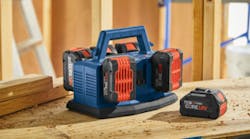Latest from Cordless Tools
Sponsored
By Jocelyn Cronin
Everyone is talking about the switch from corded to cordless power tools and the technological advancements being made to withstand a longer run-time. And while the development of cordless power tools may seem recent, the first cordless power tool was actually developed by BLACK+DECKER in 1961. Since then there have been many upgrades to cordless power tools, especially within the batteries that power them.
From NiCad to the current Lithium Ion powered battery, a lot of components in the batteries for cordless power tools have changed for the better. In addition to the changes within the construct of the battery, users are also becoming more informed on how batteries work and how to best take care of them to ensure a long lifespan. Whether a contractor uses their cordless power tool on the jobsite on a daily basis, or only pulls out a specific tool a few times a year, it is important to know how to take care of the batteries for these tools to make them last a long time, thus protecting the investment. Here are four tips for maximizing power tool battery life.
Avoid Extreme Temperatures
When considering battery health it is important to remember that extreme temperature change, especially high heat, is the enemy. Users should always try to keep the battery cool and avoid storing it in places where there is a chance for it to overheat. Batteries have minimum and maximum temperatures they can reach before damage to the battery occurs. For Bosch Power Tools’ CORE18V® batteries it is a minimum of -4 degrees Fahrenheit and a maximum of 175 degrees Fahrenheit. These type of climates should be avoided as these extreme temperatures can reduce the power or lifetime of the battery. For example, avoid leaving it in direct sunlight for extended periods of time when outside on a jobsite, and don’t store the power tool and its battery in the car on a hot day.
Further, when the battery overheats from use, in order to charge the battery, a certain internal temperature may be required before charging can begin. For example, Bosch’s CORE18V® Lithium Ion batteries require an internal temperature of 113 degrees Fahrenheit. Users should remove batteries from direct sunlight and away from heat, and take them to a cool, dry place before attempting to charge them.
Maintain Optimal Charging Routine
The second consideration in maximizing battery life is using the proper charging system. Users should choose a charger with charging modes that are applicable to their run time needs, whether a standard charging speed or a type of quick charge mode. Users on the jobsite that are working through batteries on their cordless tools rapidly may need to get their tool back to full charge in a short period of time to keep working. This is where a charger that has the capability of a quick charge mode can come in handy to rapidly get the battery back up to a 50% charge without diminishing the health and life of the battery over time. However, it is advised to only use a stronger charger if required by usage demands as increased charging speed, just like more frequent charging, adds more stress onto the battery.
Utilize Storage Mode
A storage mode is a special feature some power tool battery chargers have that promotes ease when charging a battery to an optimal level before storing a power tool for an extended period of time. If a charger with this feature is not available for the tool, users can manually monitor and charge their battery to 40-50% by looking at the charge gage. A range of 40-50% is the optimal level of charge for a cordless power tool’s battery that will be stored for several months.
Select the Proper Battery
Lastly, it is crucial to choose the proper battery for the application and power tool it is being used with. Choosing a lower capacity battery such as a 4.0 Ah or 8.0 Ah for a high power tool will require frequent charging and decrease the life span of the battery. For instance, if a contractor is overhead drilling into concrete using a rotary hammer that has a 4.0 Ah battery and they are making a lot of holes, the lower capacity battery is going to drain really quickly, leading to frequent recharging.
Overall, when using cordless power tools, users should remember that the freedom to move around a jobsite and the sole source of power comes from the battery, which requires special care. If we give special attention to heat management, charge the batteries correctly, and use them for what they are designed for, they’ll last a long time.
Jocelyn Cronin is a product manager for batteries and chargers at Bosch Power Tools, a global leader for power tools and power tool accessories. Bosch’s PROFACTOR™ cordless tool lineup is powered by its CORE18V® Lithium Ion batteries featuring Coolpack 2.0™ technology that delivers better heat management to protect cells from damage for longer battery life. For more information on Bosch cordless power tools and batteries visit this link.


